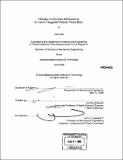A design of actuation mechanisms for use in 'huggable' robotic teddy bear
Author(s)
Lalla, Levi (Levi J.)
DownloadFull printable version (1.318Mb)
Other Contributors
Massachusetts Institute of Technology. Dept. of Mechanical Engineering.
Advisor
Cynthia Breazeal.
Terms of use
Metadata
Show full item recordAbstract
Silent, back drivable actuators were necessary for the Huggable teddy bear, a robotic companion for use in therapeutic applications. The benefits of pet therapy include a reduction in stress and an increase in rate of healing. The Huggable teddy bear will attempt to offer the same benefits through a life-like interaction with the user. Consequently, the actuators were created to be compact due to the small size of the robot. Actuators were also designed to interface with the motor control board used in the Huggable and allow for feedback for use in position control. Care was taken in the design process to address the issues of manufacturing and assembly. The two mechanisms designed for the Huggable were an eyebrow mechanism and an ear mechanism. The eyebrow mechanism has 2 degrees of freedom (DOF). This was done using a symmetrical design which couples the motion of outer eyebrows together and the motion of the inner eyebrows together. The Ear mechanism has only 1 DOF and is cable driven. These mechanisms will allow the Huggable teddy bear to provide emotional feedback as well as create a realistic response to stimulus. Up to this point, the designs and mechanisms have been built. Testing of the design will follow to ensure life-like interaction with the user.
Description
Thesis (S.B.)--Massachusetts Institute of Technology, Dept. of Mechanical Engineering, 2006. Includes bibliographical references.
Date issued
2006Department
Massachusetts Institute of Technology. Department of Mechanical EngineeringPublisher
Massachusetts Institute of Technology
Keywords
Mechanical Engineering.